The recent Bitcoin halving marked a significant event in the blockchain community, occurring as the 840,000th block was added to the Bitcoin blockchain. This fourth halving in Bitcoin’s history, which reduces the rewards miners receive for creating new Bitcoin, is revered much like major sporting events such as the World Cup and Olympics.
Following the halving, Bitcoin’s price remained stable above $63,000, but a notable surge in transaction fees ensued. This spike was attributed to the launch of Runes, a new Bitcoin-based system, which led to a flurry of transactions as speculators rushed to participate in minting digital tokens atop the blockchain.
Block 840,000, where the halving occurred, saw a record-high transaction fee of 37.6 BTC (worth over $2.4 million). The winning mining pool, ViaBTC, received the reduced reward of 3.125 BTC per block. Additionally, the post-halving blocks continued to exhibit unusually high fees, reflecting heightened competition among users.

Bitcoin (Credits: Decrypt)
The Runes protocol, developed by Casey Rodarmor, launched alongside the halving, with over 850 runes etched within an hour of its introduction. The surge in fees, particularly in contrast to pre-halving levels, underscored the unprecedented strain on the Bitcoin network.
Bitcoin developer Jimmy Song remarked on the unique stress placed on the network, with median transaction fees surging from around 100 sats/vByte to 1,805 sats/vByte post-halving. This translated to medium-priority transactions costing approximately $146 and high-priority transactions around $170.
Miners are anticipated to increasingly rely on higher transaction fees and a potential rise in Bitcoin’s price to offset the reduced mining subsidy. While some speculate that the fee spike may be temporary, others see it as a potentially lucrative revenue stream for miners in the Runes era.
However, the long-term impact remains uncertain amid ongoing developments and upgrades within the Bitcoin ecosystem, including the recent approval of spot Bitcoin exchange-traded funds (ETFs) in the U.S. and advancements like the Ordinals protocol, which promises greater utility to the network.























